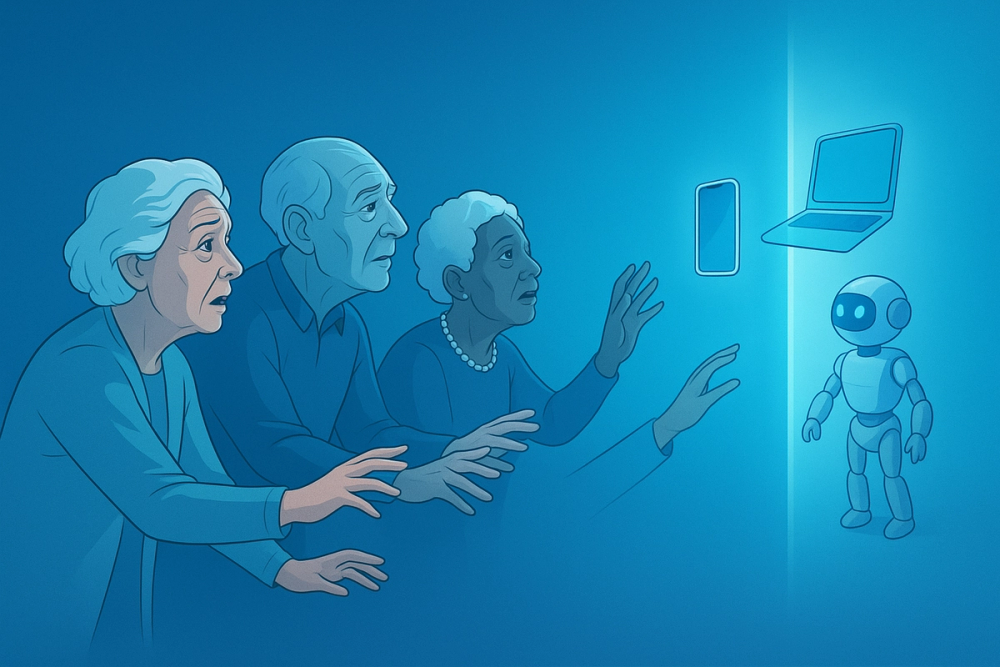The Bias in AI: Why Dementia Tech Might Not Work for Everyone
Marco Aurélio Gomes Veado
3 min read
•
October 22, 2025
Artificial Intelligence (AI) is transforming healthcare, and dementia care is no exception. From smart reminders to AI-driven diagnostics, technology now supports millions of caregivers and patients worldwide. Yet behind the innovation lies a hidden challenge of bias in AI.
When algorithms fail to represent the diversity of human experience, dementia-tech might not work for everyone.

Understanding Bias in AI
AI systems learn from data, and that data reflects the biases of the society that creates it. According to a Nature Medicine study (2024), “Healthcare AI models often perform unevenly across ethnic and socioeconomic groups because their training data underrepresents minorities, women, and older adults.”
For instance, a speech-recognition system trained mostly on younger English speakers may misinterpret the speech of an elderly person with a regional accent or mild aphasia. Likewise, MIT Technology Review has reported that facial-recognition algorithms often misread emotions in people of color due to non-inclusive image datasets.
The Representation Gap in Dementia Technology
In dementia care, such bias can have serious effects. Many AI tools now claim to detect early signs of cognitive decline through speech analysis or behavior monitoring. Yet these systems are usually trained on Western, urban, and affluent populations, as the World Alzheimer Report by Alzheimer’s Disease International notes.
This representation gap means individuals in rural or low-income regions, especially across Africa, Latin America, and Southeast Asia, are at risk of misdiagnosis or exclusion.
Cultural variations in how memory loss is expressed can confuse AI models built on narrow datasets, resulting in false positives or false negatives.
Read here about “dementia and inequality”
Socioeconomic Barriers and Accessibility
Bias isn’t only technical. It’s economic as well. The World Health Organization’s Global Status Report on Dementia (2023) highlights that many digital health tools depend on costly devices or stable internet access, leaving out millions in low-resource settings.
Even when affordable, apps developed in English may alienate caregivers who speak other languages or lack digital literacy.
As a result, dementia tech can reinforce health inequality, favoring those with access to private care while excluding the vulnerable, precisely the opposite of what ethical AI should achieve.
Ethical and Human Considerations
Bias in dementia AI raises profound ethical questions. Dementia touches identity, autonomy, and dignity. When flawed algorithms shape diagnosis or care, they can undermine trust and fairness.
The Stanford Center for Ethics in AI emphasizes the need for “human-centered and culturally responsive design” in healthcare algorithms. Involving caregivers, clinicians, and people living with dementia from multiple cultures during design and testing isn’t optional: It’s essential for building equitable technology.
Building Fair and Inclusive Dementia AI
To ensure dementia tech benefits everyone, developers and policymakers must act decisively:
- Diversify Training Data: Collect inclusive datasets representing different languages, ethnicities, and social realities (Nature Medicine, 2024).
- Collaborate Across Borders: Encourage partnerships between universities, NGOs, and local communities worldwide (WHO, 2023).
- Cultural Localization: Design multilingual and culturally sensitive AI interfaces.
- Affordable Access: Promote open-source dementia tech and public funding for low-income regions.
- Continuous Auditing: Regularly evaluate AI systems for bias as new data emerges.
What This Means for Caregivers
• AI tools are helpful, but should never replace professional advice.
• Bias can limit accuracy; always confirm results with healthcare providers.
• Choose dementia-care apps that are multilingual, affordable, and user-tested on older adults.
• Advocate for inclusive design by sharing your feedback with developers and researchers
Conclusion
AI holds immense promise for dementia care, but only if it’s inclusive, ethical, and fair. Tackling bias isn’t just a technical challenge; it’s a moral responsibility.
When AI reflects the diversity of humanity, it can empower every person affected by dementia, restoring not just memory, but dignity, hope, and equality.
Join the MCI and Beyond biweekly newsletter to receive caregiver-friendly insights on dementia treatments and care strategies.
References
1. World Health Organization. (2023). Global Status Report on the Public Health Response to Dementia. Geneva: WHO. htps://www.who.int/publicatons/i/item/9789240033245
2. Nature Medicine. (2024). Bias in Artificial Intelligence and Machine Learning for Healthcare. htps://www.nature.com/nm/
3. MIT Technology Review. (2023). The Invisible Bias Inside AI Healthcare Systems. htps://www.technologyreview.com/
4. Alzheimer’s Disease International. (2022). World Alzheimer Report 2022: Life After Diagnosis. htps://www.alzint.org/resource/world-alzheimer-report-2022/
5. Stanford Center for Ethics in AI. (2023). Inclusive AI: Building Equitable Health Technologies. htps://ethicsinaicenter.stanford.edu/
6. MCI and Beyond. (2025). Blog on Dementia Care and AI Innovation. htps://mciandbeyond.org/en/blog
Keywords: AI bias, dementia care technology, inclusive AI, healthcare innovation, digital inequality, dementia diagnosis, ethical AI, accessibility in dementia care, Alzheimer’s research, tech for aging

